To Paris! Battles of Arcy-sur-Aube and Fère-Champenoise
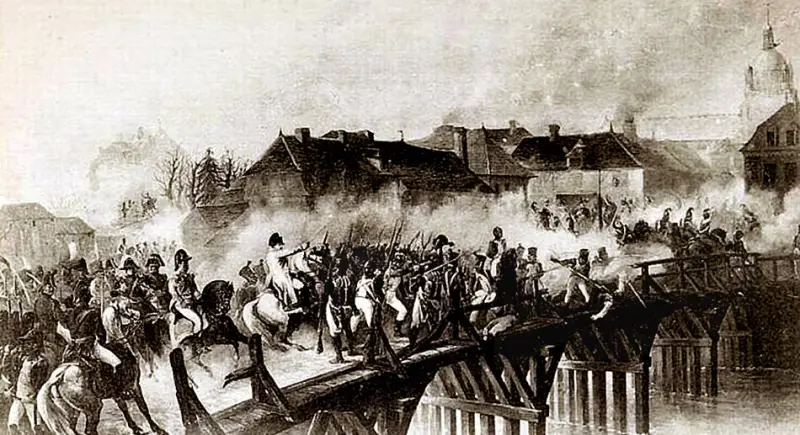
Napoleon at the Battle of Arcy-sur-Aube. Hood. Jean-Adolphe Beauce
Schwarzenberg offensive
Meanwhile, while Blucher's army was repelling the onslaught of French troops near Craon and Laon (How two Russian divisions stopped Napoleon's army; Battle of France: Assault on Laon), the Austrian commander-in-chief Schwarzenberg again launched an attack on Paris. He did this, as before, very carefully and slowly, although in front of him there was only a weak screen from MacDonald. At the same time, he was urged on by the Russian sovereign Alexander Pavlovich.
Having learned about the defeat of the Russian-Prussian corps of Saint-Prix near Reims, Schwarzenberg again wanted to retreat. By March 18, 1814, the Main Army crossed the Seine and stretched for almost 100 miles from Sens through Provins, Mary, Arcy to Brienne. The army was scattered again; it could have been defeated piecemeal, as had already happened in February (Napoleon defeated Schwarzenberg's corps at Morman and Montreux). Angered by the indecision of the Austrian commander-in-chief, Alexander I took command and began to gather troops in the area between Arcy-sur-Aube and Troyes.
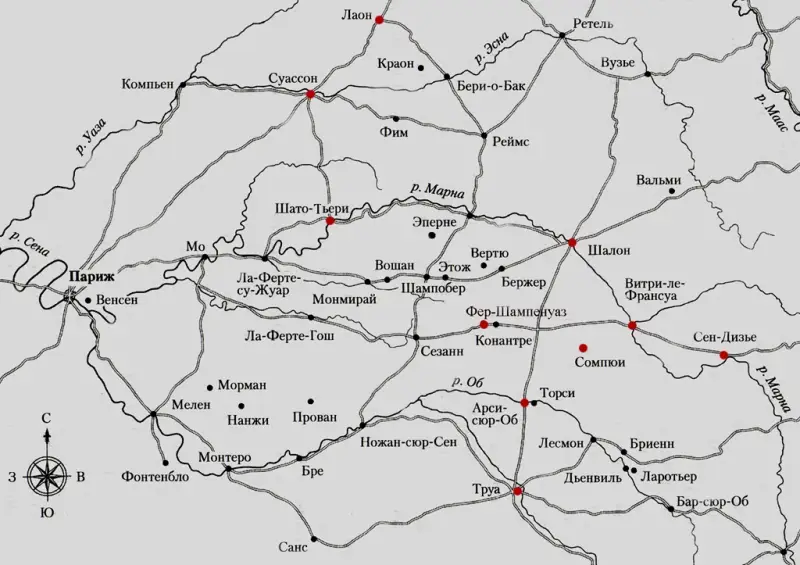
Napoleon, after the success at Reims and the short rest that he gave the army, led troops against Schwarzenberg's army, since it was closer to Paris than Blücher's army. Macdonald alone could not stop the allied army, which had a triple superiority in strength. Leaving a 20-strong barrier under the command of Marmont and Mortier to observe Blücher, on March 17, Napoleon led the remaining 30 soldiers to Arcy-sur-Aube, hoping to take the enemy by surprise.
At this time, Blucher's army set out on March 18 from Laon in three columns: Bülow's troops went to Soissons, the corps of York and Kleist - to Chateau-Thierry, and the corps of Langeron, Saken and Wintzingerode, led by the commander-in-chief himself - to Chalons, to join the Main Army .
Moving along the Ob River on both its banks (cavalry on the left, infantry on the right), the French vanguard reached Arsi by March 20 and took the city and the bridge across the river without any problems. Before this, the Bavarians of General Wrede retreated from the city, fearing to be surrounded. Napoleon believed that Schwarzenberg, as before, would begin a retreat.
However, the Main Army gathered its main forces into a fist and did not retreat, since the Russian sovereign took command. This confused the plans of the great Corsican, who thought that he would only deal with the enemy's rearguards.
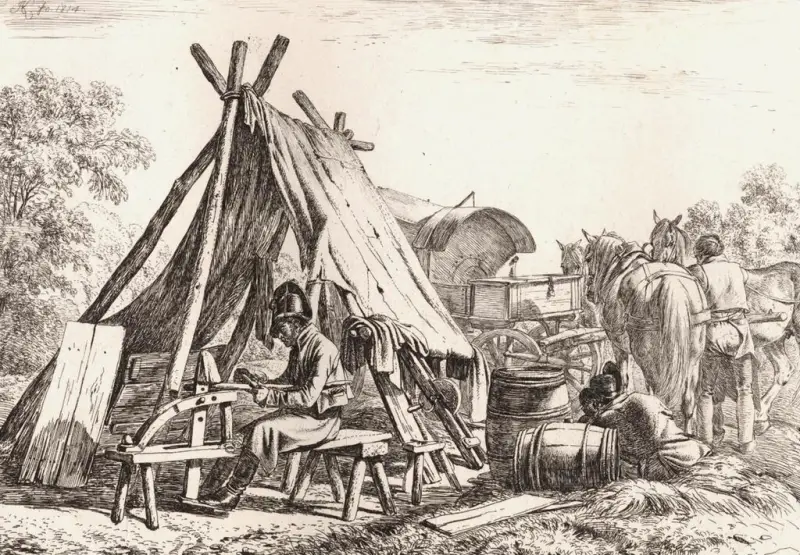
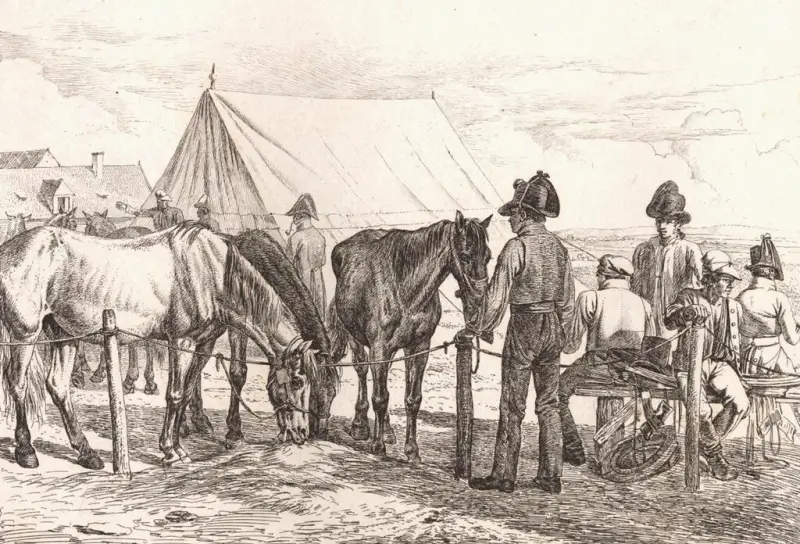
Scenes of a military camp, 1814. Hood. Johann Adam Klein
Battle of Arcy-sur-Aube. Meeting engagement
By noon on March 20, the emperor himself arrived at the French troops and ordered Sebastiani's cavalry to pursue the enemy. But as soon as the French cavalry left Arsi on the road to Troyes, it was attacked by the allied cavalry - the Cossacks of Major General Paisiy Kaisarov and the hussars of Archduke Joseph. The attack was unexpected for the French, and they fled. Bonaparte had to personally stop the fleeing troops on the bridge in Arcy: “Which of you will cross the bridge before me?”
Later, when the panic subsided, the approaching division of the Old Guard of General Friant drove the allied cavalry out of the city. Soon the rest of the French infantry arrived. At the same time, a stubborn battle continued until the evening on the French left flank for the village of Torcy up the Au (on the French left flank), where Ney’s Young Guard twice occupied positions near Wrede’s Austro-Bavarian corps. On the right flank, a column under the command of Prince William of Württemberg attacked the French cavalry at Mary-sur-Seine and Plancy. As a result of fierce cavalry battles, the Allies managed to capture Mary-sur-Seine.
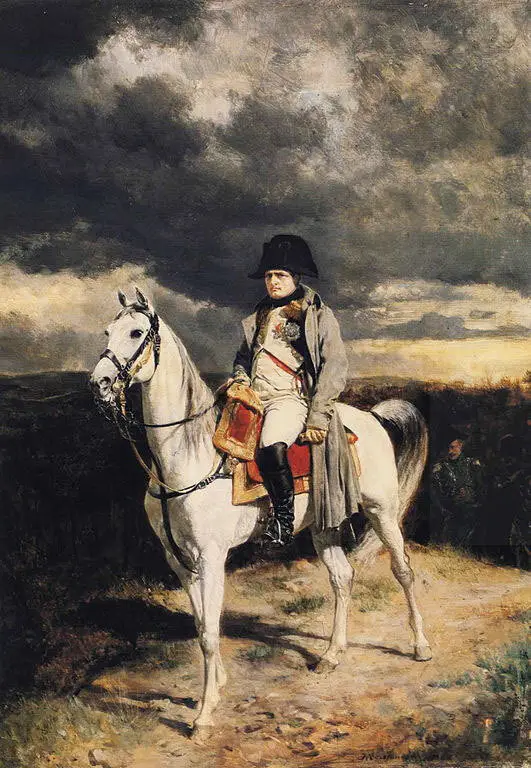
Napoleon at Arcy-sur-Aube, 1814. Hood. Jean-Louis-Ernest Meissonnier
By the evening of March 20, the French position was a semicircle, the edges of which abutted the Aube, and Arsi was inside. There were about 25 thousand French, and 60 thousand allied troops stood against them. On the right flank of the Allies stood Wrede's Austro-Bavarian Corps, in the center were the Russian units of Barclay de Tolly, and on the left flank were the Austrians of Giulai.
After the end of the battle for Torsi, General Sebastiani, reinforced by a 2-strong cavalry detachment, again went on the attack, hoping to take revenge for the day's defeat. He overthrew the troops of General Kaisarov, captured the battery of Wrede's corps, disrupting his left flank. But then the Tauride Grenadier Regiment and the Russian 3rd Cuirassier Division launched a counterattack, stopping the French and returning the battery.
By evening, the Allies had gathered almost the entire army - up to 100 thousand soldiers. Denouette's division (up to 7 thousand) approached the French at night. But the corps of Oudinot and MacDonald were late. Powerful Allied artillery (about 300 guns) opened fire on enemy positions. Many witnesses to the battle noted that Bonaparte was looking for death. He deliberately showed himself in the most dangerous places, unnecessarily exposing himself to mortal risk. One of the shells exploded nearby, wounding the emperor's horse and dousing him in mud. But Napoleon himself again did not take anything.
This was the last battle of the 1814 campaign in which the Emperor was personally at the front line supporting the soldiers.
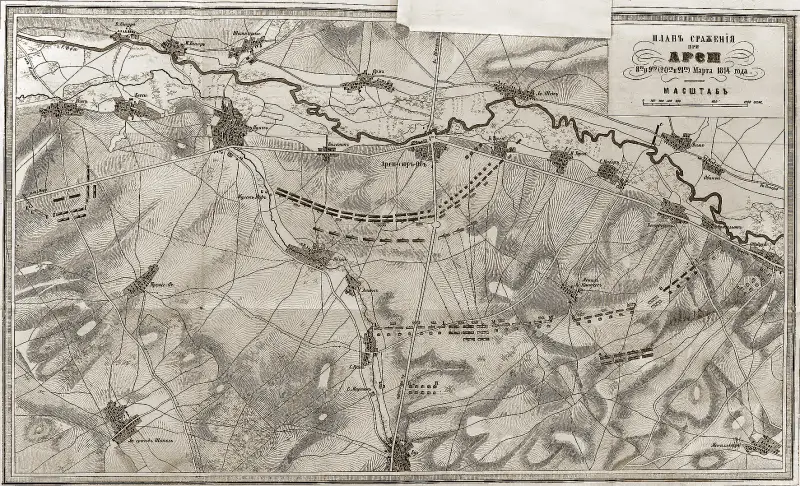
Plan of the battle of Arcy-sur-Aube on March 8–9 (20–21), 1814.
French retreat
The French historian M. Thiers reported a conversation between Napoleon and General Sebastiani, which took place on the evening of March 20 and characterizes the strategic position of the French army:
– I will say that Your Majesty undoubtedly has new resources that we do not know.
– Only those that you see before your eyes, and no others.
“But then why don’t your Majesty think about raising the nation?”
- Chimeras! Chimeras borrowed from memories of Spain and the French Revolution. To raise a nation in a country where the revolution destroyed the nobles and clergy, and where I myself destroyed the revolution!
On the morning of March 21, the two armies took up positions in anticipation of a decisive battle. Despite the triple superiority in forces, Schwarzenberg hesitated and was inclined to go on the defensive. The main stimulator of the combat activity of the Main Army, Emperor Alexander, fell ill and was absent.
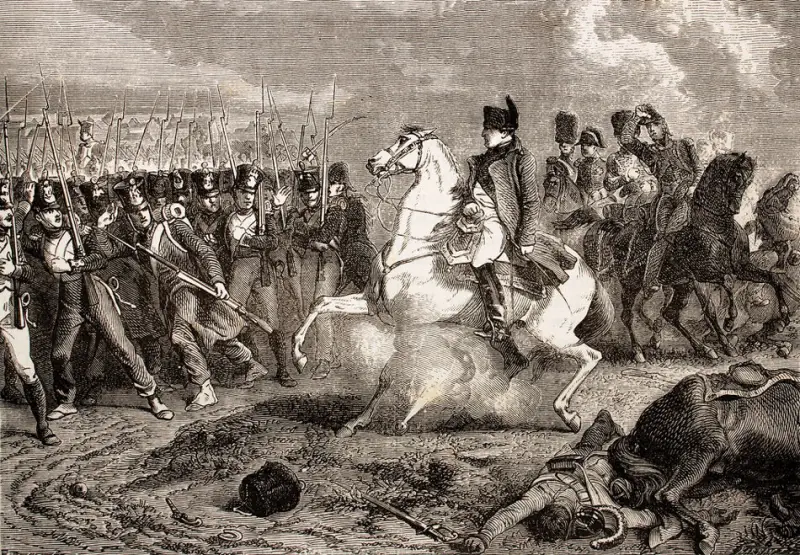
Battle of Arcy-sur-Aube. Napoleon's horse is blown up by a grenade. Illustration for the book by Adolphe Thiers "History Consulates and empires"
Napoleon, having learned that in front of him was the entire enemy army, which was standing in a more advantageous position, realized the pointlessness of a further offensive and by noon began to withdraw troops beyond the Ob.
Schwarzenberg hesitated and only after a two-hour military meeting he ordered an attack. The Austro-Russian army quickly moved forward, but the enemy had already left. The approaching troops of Marshal Oudinot became the vanguard and held back the enemy in the city. In the evening the French left and burned the bridges behind them. On the other side of the river, French artillery prevented the Allies from restoring the crossings.
Losses on both sides were approximately equal - approximately 4 thousand people. Russian military historian A. Kersnovsky estimates the Allied losses at 3 thousand people, the French lost up to 7 thousand people.
Thus, thanks to his indecision, perhaps also under the influence of the political guidelines of the Viennese court, Schwarzenberg, with complete superiority in forces and means, a good position, missed the opportunity to completely defeat the French army. Moreover, the French army was simply allowed to leave quietly.
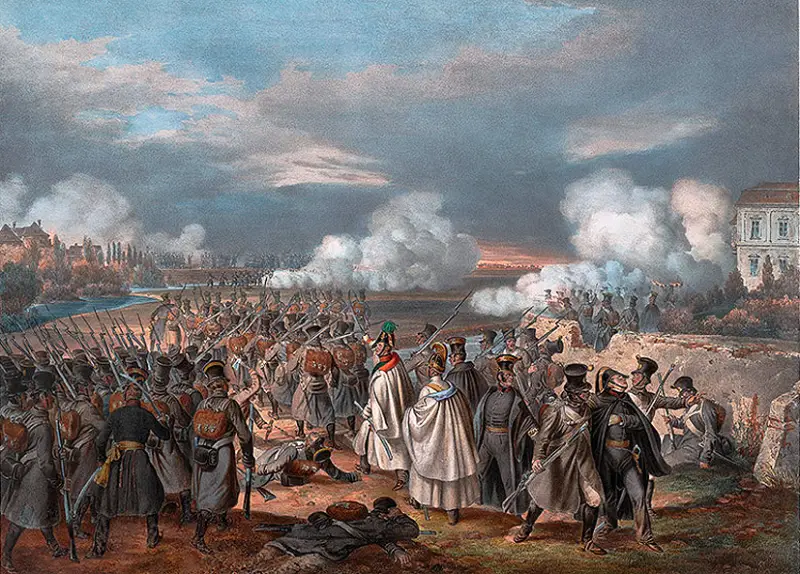
Austrian infantry at the Battle of Arcy-sur-Aube
To Paris!
Napoleon, joining forces with MacDonald's corps, bypassed Vitry, where the Allied garrison was, and on March 23 was in Saint-Dizier on the Marne. From here he planned to disturb the rear of the enemy army, pulling it towards himself. Napoleon's maneuver, which withdrew troops to the east, caused bewilderment in the allied army. The Cossacks reported: “The enemies are retreating not to Paris, but to Moscow.”
After the enemy left Arsi, the allied headquarters did not know what Napoleon would do, since the emperor camouflaged his marches well, leaving cavalry barriers. But on the evening of March 22, the Cossacks captured the emperor’s courier, who informed Marie-Louise that he was going to attack the enemy’s communications in order to pull their troops away from the French capital.
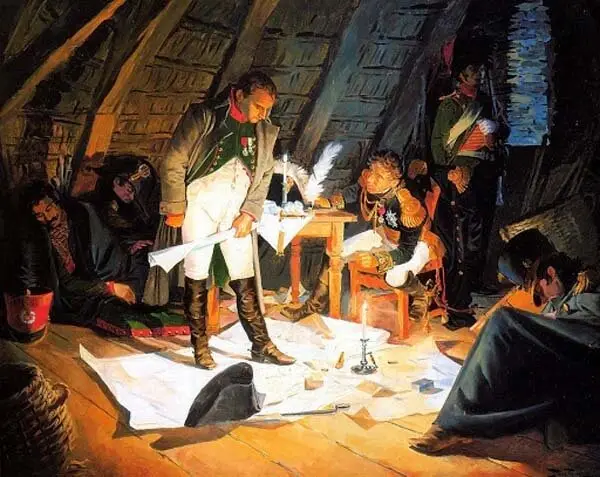
Napoleon during the French campaign of 1814
On March 23, a military council was held in Puzhi, at which the Russian Tsar proposed two options: go to Napoleon and attack him, or decisively go to Paris, while hiding his actions. Opinions varied. Berclay de Tolly was for a decisive battle with Bonaparte, Volkonsky, Dibich and Tol (with various reservations) were for the second option.
As a result, on March 24, they decided to march on Paris.
Perhaps Alexander I accepted the advice of a distant relative and blood enemy of the French emperor, a Russian diplomat of Corsican origin, Charles-Andre (Karl Osipovich) Pozzo di Borgo, who was at Allied headquarters:
Touch Paris with just your finger, and the colossus Napoleon will be overthrown, you will thereby break his sword, which you are not able to snatch from him.”
Napoleon later admitted that this advice of Pozzo di Borgo "in one fell swoop decided the fate of France, European civilization, and, consequently, the fate of the world».
Taking advantage of the fact that Paris was almost undefended and Napoleon was far to the east, it was decided to march with two armies against the French capital. They hoped to capture it before the return of Napoleon Bonaparte. As a diversionary maneuver, a 10-strong separate Wintzingerode cavalry corps with a curtain of Cossack detachments was sent against the French army.
Sovereign Alexander I and his retinue caught up with Field Marshal Schwarzenberg and the Prussian King Frederick William on a small hill near the village of Plancy. Here, in the open air, the decision of the Russian headquarters was announced. The Prussian king immediately agreed with Alexander Pavlovich. Schwarzenberg did not particularly resist, although his headquarters was against it.
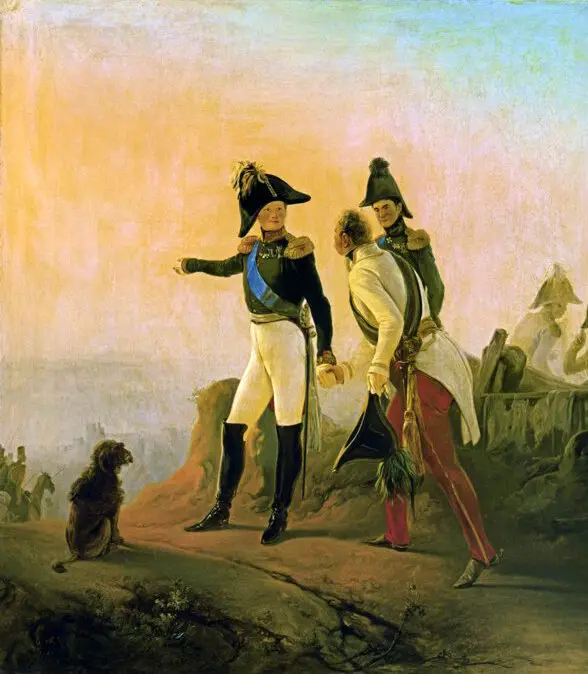
Scene in a military camp. Emperor Alexander I, Prince Pyotr Mikhailovich Volkonsky and Austrian Field Marshal Karl zu Schwarzenberg. Unknown artist
The defeat of the corps of Marmont and Mortier
On March 25, the Allied forces (by this time the armies of Blucher and Schwarzenberg had come into contact as vanguards) moved west to Paris.
The main forces of the Main Army marched along the road from Vitry through Fère-Champenoise to Cézanne, with the cavalry of Palen and the Duke of Württemberg in the vanguard. To the south, parallel to the main forces, marched the army reserves - the troops of Barclay de Tolly. To the north were the corps of Lanzheron and Saken from the Silesian army. The cavalry divisions of Baron Korf and Vasilchikov were in the vanguard. Field Marshal Blucher's health improved and he was traveling with the troops. The weather was excellent and the morale of the Allied troops was high.
Meanwhile, the corps of Marmont and Mortier, Belliard’s cavalry (about 17 thousand people) were coming towards the allied forces from Paris, and to the north there was a convoy of ammunition and food to Napoleon, accompanied by two divisions of the National Guard of generals Pacteau and Ame (about 4–6 thousand soldiers) . The French troops were going to join Napoleon in Vitry and did not know that the main forces of the enemy were coming towards them.
The Allies also neglected reconnaissance and did not know that the French were coming towards them.
At about 8 o'clock in the morning on March 25, the allied cavalry ran into Marmont's corps at Fer-Champenoise. Palen's Russian light cavalry began to attack from the right flank, the cavalry of Crown Prince William of Württemberg - from the left, bypassing the enemy. Marmont began to retreat and requested help from Mortier, who led the Young Guard. The French formed a common battle line near the village of Sommes. The French held the position for about two hours, then decided to take a more convenient position at Fer-Champenoise.
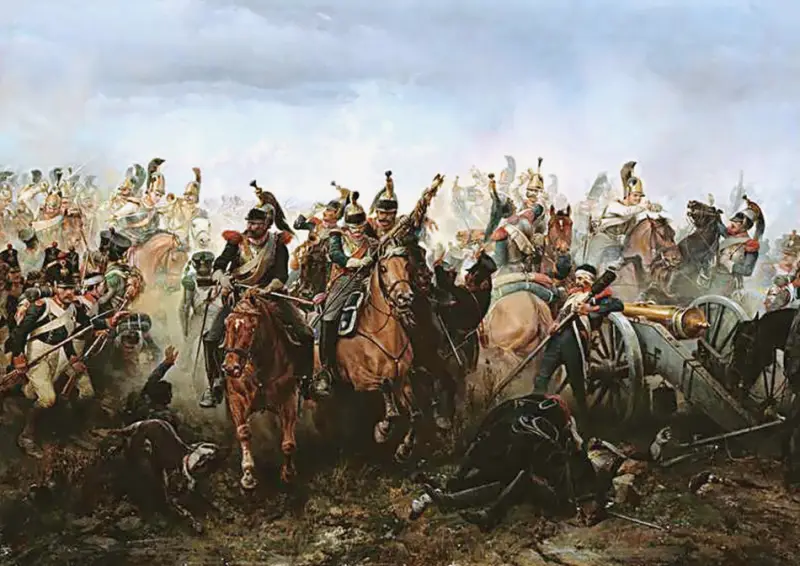 Bogdan Villevalde "Life Guards Cavalry Regiment at the Battle of Fer-Champenoise on March 13, 1814", 1891.
Bogdan Villevalde "Life Guards Cavalry Regiment at the Battle of Fer-Champenoise on March 13, 1814", 1891.Soon the Austrian cuirassiers of General Nostitz arrived, and in the afternoon the Russian cavalry arrived under the command of Tsarevich Konstantin as part of the 1st Guards Cuirassier Division of General Depreradovich, as well as the Uhlans, Hussars and Dragoon Guards regiments. The total number of allied cavalry reached 12 thousand people.
The French began to retreat along the defile, which was sandwiched between the river and the ravine. At first, the French infantry successfully retreated, covered by Bordesoul's cuirassiers and Roussel's dragoons.
But at 2 o'clock in the afternoon a hurricane of wind and rain began. In the pouring rain it was impossible to shoot back from the advancing allied cavalry. The French soldiers fought back with rifle butts and bayonets. Two French squares broke formation and were crushed by the Russian Horse Guards. The remaining French squares fled through Fer-Champenoise, losing almost all their artillery.
The French units were saved from complete destruction by Leclerc's 9th marching regiment (400 horsemen), which arrived at that time. The French regiment went on the attack and stopped the allied units that were upset during the pursuit. Marmont and Mortier were able to withdraw the broken corps, losing thousands of soldiers and almost all their artillery.

V. F. Timm. Battle of Fer-Champenoise March 13 (25), 1814
The defeat of the National Guard divisions
On the same day, north of Fer-Champenoise, at around 11 o'clock in the morning, a clash occurred between the French infantry divisions of generals Pacteau and Ame, mainly consisting of the National Guard, which escorted large artillery and food convoys, with the cavalry of Field Marshal Blucher in the person of Korff and Vasilchikov from Blucher's army .
The French, who were resting after the night march, were unpleasantly surprised by the enemy cavalry that appeared. Pacteau, abandoning the convoys, tried to withdraw the guns and offer resistance. Realizing that the forces were unequal, he began to take the soldiers to Fer-Champenoise. On the way, the French ran into Depreradovich's cuirassier and were surrounded.
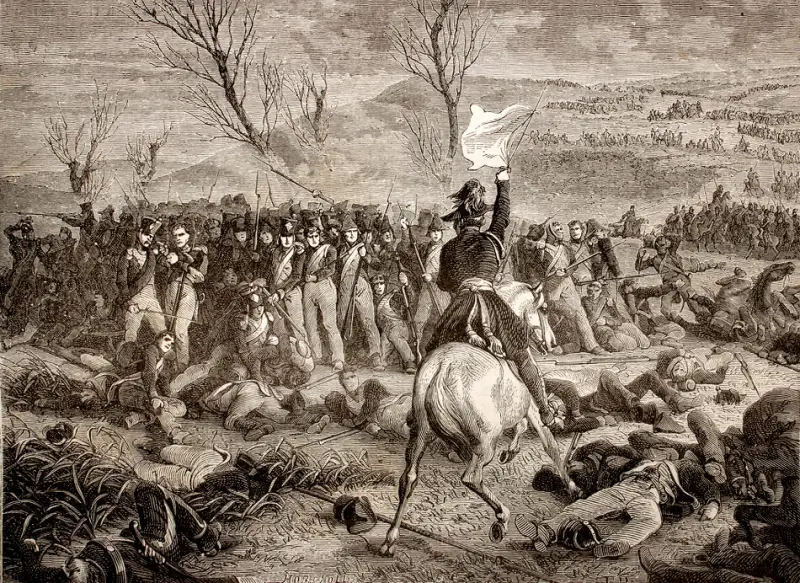
The heroism of the National Guard soldiers in the swamps of Saint-Gond. Illustration for the book “History of the Consulate and Empire” by Adolphe Thiers
Despite the desperate situation, the French refused to lay down weapon and fought bravely. They fought their way through enemy cavalry for several hours. French soldiers once again showed their courage, tenacity and discipline. This was a serious, strong opponent. Pacteau, seeing that the path to Fer-Champenoise was cut off, turned to Petit-Morin to go into the Saint-Gondian swamps. By this time, a third of the detachment had already been killed, two of the six squares were defeated.
The Allies brought up their guns. The Russian battery of horse artillery (4 guns of Lieutenant Pukhinsky) opened fire with grapeshot, making holes in the square. The cavalry completed the rout.
A participant in Muravyov’s battle recalled:
The Russian sovereign Alexander Pavlovich, wanting to stop the massacre that had begun, gave the order to stop the battle. But in the heat of battle, the order did not reach the soldiers. Then the tsar personally with his convoy drove into the dying French square and stopped the massacre.
Two French divisional generals Pacteau and Ame and from 1,5 to 3 thousand soldiers were captured, and 12 cannons and the entire convoy became a trophy for the Allies. Hardly 500 soldiers from the entire convoy managed to escape in the Saint-Gond swamps; the rest lay down on the battlefield or were captured.
The peculiarity of this battle is that the French were defeated exclusively by allied cavalry and artillery. A rare case when cavalry was able to defeat superior forces of regular infantry.
Russian historian M.I. Bogdanovich brought the total French losses at Fer-Champenoise to more than 11 thousand soldiers and 75 guns. Most of these losses were prisoners (up to 8 thousand people). Russian historian A. Mikhailovsky-Danilevsky reports the Allied losses of 2 thousand people.
The Russian commander Barclay de Tolly ordered the French prisoners, most of whom were recruits, to be fed and bandaged and sent home.
There were no longer French barriers between Paris and the allied armies. The remnants of the corps of Marmont and Mortier, which had almost no artillery (less than 10 guns), retreated to the capital.
On March 30, the allied armies reached Paris.
The battle for the French capital began.
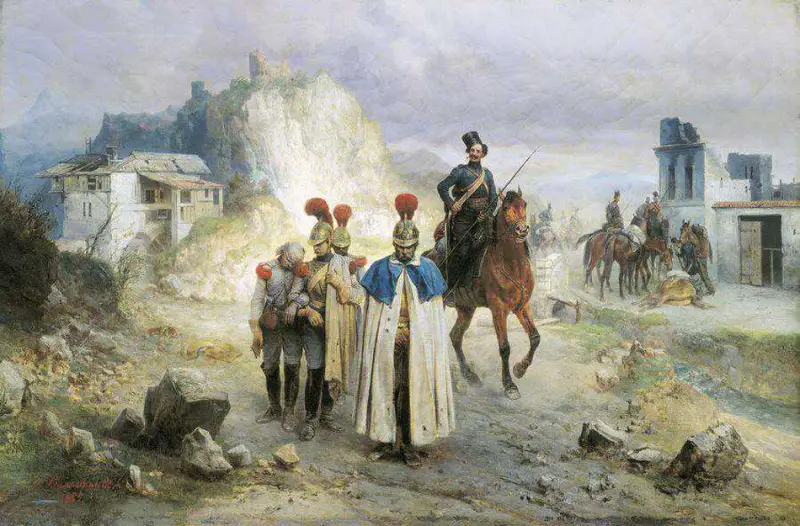
They were captured in 1814. Hood. Bogdan Villevalde.
Information